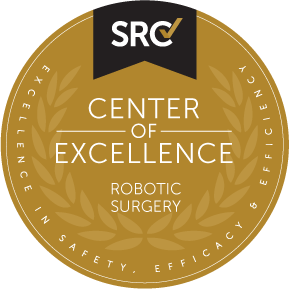Institute for Minimally Invasive Surgery
The Institute for Minimally Invasive Surgery at Cabell Huntington Hospital was established to advance the science and practice of minimally invasive surgical procedures by providing our team of experienced and skilled specialists with the most advanced technology and devices.
Minimally invasive surgery and therapy is important because of the numerous patient benefits it offers including:
- Shorter hospital stay
- Less post-operative pain and faster recovery
- Less risk of infection
- Decreased blood loss
- Less scarring
- Quicker return to normal activities
Robotic Surgery
 Cabell Huntington Hospital was the first to bring da Vinci® robotic surgery to the region in 2006, and has performed numerous surgeries, perfecting the brilliance of minimally invasive technology. Today, Cabell Huntington Hospital's Robotics Surgical Center features three da Vinci systems, providing surgeons with unparalleled precision, dexterity and control. Each robot consists of three main parts: the surgeon's console, which includes a video screen, hand controls and foot pedals; the laparoscopic tower; and a separate bedside cart that is equipped with four arms, one is a camera and three are instruments.
Cabell Huntington Hospital was the first to bring da Vinci® robotic surgery to the region in 2006, and has performed numerous surgeries, perfecting the brilliance of minimally invasive technology. Today, Cabell Huntington Hospital's Robotics Surgical Center features three da Vinci systems, providing surgeons with unparalleled precision, dexterity and control. Each robot consists of three main parts: the surgeon's console, which includes a video screen, hand controls and foot pedals; the laparoscopic tower; and a separate bedside cart that is equipped with four arms, one is a camera and three are instruments.
The da Vinci® Xi™ System is the newest addition to the Robotics Surgical Center. It uses the latest in surgical and robotic technologies and is beneficial for performing several complex surgeries.
The robotic systems offer:
- Enhanced 3D, high-definition vision of the operative field with up to 10 times magnification
- A dual console allowing a second surgeon to assist
- Superior visual clarity of tissue and anatomy
- Surgical dexterity and precision far greater than even the human hand
- New ergonomic settings for greater physician comfort
Although it is referred to as robotic surgery, it is important to know that surgery with da Vinci does not place a robot at the controls. The surgeon, who has been through extensive da Vinci training, is controlling every aspect of the surgery with the assistance of the da Vinci robotic platform.
Surgeons can perform complex surgical procedures through just a few small incisions, using a high-definition 3D vision system and tiny wristed instruments that bend and rotate far more than the human wrist. Robotic surgery typically results in smaller incisions, less pain, a shorter hospital stay, a faster return to normal daily activities and the potential for better clinical outcomes.
Laparoscopic and Endoscopic Surgery
Non-robotic minimally invasive surgery is performed through small incisions or natural openings such as the mouth, nose or rectum to reach areas of concern. During an endoscopic procedure, an endoscope, a thin tube with powerful light and a tiny camera, is used to reach internal organs. The surgeon watches a video monitor to view problems within the body, take biopsies of any abnormal areas or remove polyps, cysts and tumors. This technique allows the surgeon to see inside the patient's body and operate through a much smaller incision than would otherwise be required of traditional open surgery.
During a laparoscopic procedure the surgeon will make several small incisions instead of a single large incision. Small tubes are placed through these incisions and into the abdomen. Carbon dioxide gas is used to inflate the abdomen in order to give the surgeon room to work. This allows the surgeon to use a camera attached to a thin metal telescope (called a laparoscope) to watch a magnified view of the inside the abdomen on video monitors. Special instruments have been developed for the surgeon to pass through the tubes to take the place of the surgeon’s hands and traditional surgical instruments.
The benefits of endoscopic and laparoscopic procedures are:
- small incisions, few incisions or no incisions
- low risk of infection
- less post-operative discomfort since the incisions are much smaller
- quicker recovery time
- earlier return to full activities
- much smaller scars
- less internal scarring
